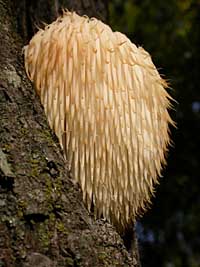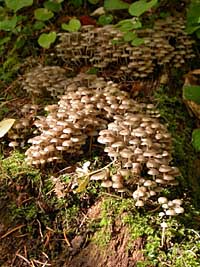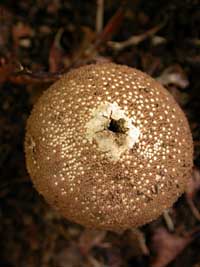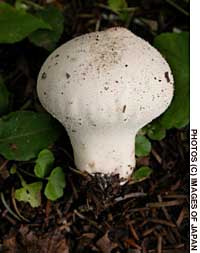Taking delight in decomposition
By Mark Brazil | Nov 16, 2005
FALLING FOR FUNGUSThe autumn carpet of leaves along woodland and mountain trails deepens as each breath of wind spins more and more foliage from the trees and sends flakes of colors whirling across the landscape. Storms rip whole canopies of leaves away, snapping off branches and sending twigs raining down. Below, the debris accumulates.
If there were no natural processors to break down that mass of fallen vegetation, think how it would all build up year after year. We would be overwhelmed by an ever-thicker carpet of organic detritus and at risk of fires; yet year-after-year we instead find deepening soils.
For that, we are indebted to the decomposers, the myriad fungi that, along with bacteria, have the extraordinary capacity to recycle cellulose and, with it, vital elements such as nitrogen and phosphorus back to the ecosystem.
The approximately 100,000 known species of mushrooms, rusts, molds, mildews, stinkhorns, puffballs, truffles and so on that are now assigned an entire kingdom to themselves, come in so many bizarre and fascinating forms that it is difficult to get to grips with their diversity.
In their shape, texture and size, they range from some resembling jelly-like cups to others like golf-balls or tree-beards, with one group even similar to mammalian male genitalia.
Whatever their differences, though, fungi share a particular characteristic, that of reproducing by microscopic wind-borne spores. This very fact means that many species have enormous ranges, and I have found fungi that I grew up recognizing in Britain also growing in North America and here in Japan.
As summer gives way to fall, migratory birds are a welcome distraction during mountain hikes; but as autumn settles in, then shades toward winter, the birds move on and it is the fungal delights on the forest floor that distract.
Here a cluster of delicate gray-brown parasols is gathered along a fallen, mossy trunk as if lined up in waiting. There, growing on the forest floor, is a solitary splash of red; a broad, hefty cap flecked with white atop a thick stem like something straight out of a fairy tale. Above, meanwhile, a rather glaucous, somewhat wooden sculpture protrudes like a shelf bracket from a birch trunk.
Personally, I have a soft spot for the small white golf ball-like fungi that are abundant just now. They begin so white and firm (and are edible at that stage), but then their surfaces wrinkle and crack, while inside, their white flesh browns, until finally it turns dustlike in the now leathery pouch from which a tiny pore pouts upward. These spore-puffers await the perfect opportunity to disperse their contents: rainfall. Splashing drops, filtered down through the autumn leaves, occasionally land like liquid bombs that impact and deform the stretched skin of these puffball fungi, the pressure of each drop forcing a smokelike puff of air and many thousands of dustlike spores out from the apical pore and sending them on their way. And then the puffball’s elastic skin bounces back into shape, sucking in a tiny breath of air as it does, so that when the next raindrop strikes, another blast of spores is sent out to ride the vagaries of the wind.
Despite the dampness and early morning chill in the air, there is a wholesome earthiness to the forest bouquet at this season, a mixture of fine loam and fungal scents. Perhaps it is the spores of the countless fungi that combine with the smells of their fruiting bodies to create the unmistakeable cool, autumn smell of temperate woods and forests. Close your eyes, take a deep breath — there’s no doubt, autumn is here.
Fungi, unlike green plants, are unable to produce their own food by means of photosynthesis. Instead they acquire their nutrients from living or dead plants, animals or other fungi (as animals do), and in so doing they help process the accumulating debris of a season of plant growth.
But that process is not the role of the visible mushrooms we see above ground at this time of year, since they are merely the fruiting bodies. The business end of the fungus consists of the mycelium, a mass of intertwined, slender tubular threads, or hyphae, growing beneath leaf litter in humus-rich soils, in dung or in rotting wood, depending on the species. They secrete powerful digestive enzymes that allow them to break down even cellulose into sugars and amino acids that can be absorbed through the fungal cell walls.
The delightful colors and scents of the season tempt me out week after week, but every so often I experience a sudden jolt of distasteful recognition. Not all is sweet in the natural world, and in fact there is a particularly noxious smell that once in a while stops me in my tracks. It is a smell that I recall from childhood, unmistakeably unpleasant, yet at the same time as fascinating as the rank reek sniffed occasionally where a fox has crossed the trail.
Like the fox’s reek, which tells of another creature’s perambulations in the forest, this stink is an odor linked to a fascinating story. The rotting stench arises from shady areas among dwarf bamboo, or from damp, herb-rich patches on the forest floor overlying rotting wood. Wherever that stench emanates there is sure to be a stinkhorn.
The unmistakable appearance and fetid smell of this fungus renders it unmistakable. Standing proud and tall, like a grossly pallid erection protruding from the leaf litter, this odoriferous fungi goes by the bluntest of scientific names, Phallus impudicus — shameless penis!
This is a fungus that can be found from Europe to Australia, from Asia to North America, fruiting in northern temperate regions from July to November. They grow from strange gelatinous egg-like structures some 3 or 4 cm across that were believed in the past to be the eggs of witches, or even of the Devil! When the conditions are right, the egg erupts and a spongy white shaft emerges, extending a single, unbranched, erect stalk 10 to 25 cm tall. The swollen conical head or fruiting cap, which may be 3 to 5 cm across, is olive green and coated with a putrid, mucilaginous slime that is the spore mass.
This fungus has good reason to stink, and it is no mere coincidence that its stench resembles decaying flesh; its purpose is to attract flies to its spore-laden slime. Having walked in the malodorous slimy spore mass, the flies ultimately transport some of it elsewhere, so serving to disperse the species further.
On your autumn forays to view the beautiful colors, remember to breathe in deeply to savor the fungal scents (and stinks) of the season.




